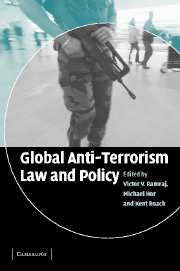Book contents
- Frontmatter
- Contents
- List of contributors
- Acknowledgements
- 1 Introduction
- PART ONE Theoretical Perspectives on Anti-Terrorism Law and Policy
- PART TWO A Comparative Study of Anti-Terrorism Measures
- PART THREE Anti-Terrorism Law and Policy in Asia
- PART FOUR Regional Cooperation
- 19 Southeast Asian cooperation on anti-terrorism: the dynamics and limits of regional responses
- 20 Anti-terrorism law and policy: the case of the European Union
- PART FIVE Anti-Terrorism Law and Policy in the West
- PART SIX Anti-Terrorism Measures in Africa, the Middle East and Argentina
- Index
19 - Southeast Asian cooperation on anti-terrorism: the dynamics and limits of regional responses
Published online by Cambridge University Press: 21 July 2009
- Frontmatter
- Contents
- List of contributors
- Acknowledgements
- 1 Introduction
- PART ONE Theoretical Perspectives on Anti-Terrorism Law and Policy
- PART TWO A Comparative Study of Anti-Terrorism Measures
- PART THREE Anti-Terrorism Law and Policy in Asia
- PART FOUR Regional Cooperation
- 19 Southeast Asian cooperation on anti-terrorism: the dynamics and limits of regional responses
- 20 Anti-terrorism law and policy: the case of the European Union
- PART FIVE Anti-Terrorism Law and Policy in the West
- PART SIX Anti-Terrorism Measures in Africa, the Middle East and Argentina
- Index
Summary
Introduction
Some have seen Southeast Asia as a potential ‘second front’ in the US-led war on terrorism. The sharpest evidence of this was the 2002 Bali bombings. Problems in Aceh (Indonesia), Mindanao (the Philippines) and in southern Thailand have been linked with Muslim groups that have differences with their respective capitals. They have resorted to action that has been described as ‘terrorist’. Member states in the Association of Southeast Asian Nations (ASEAN) have responded differently to issues within their own borders, as well as to US-led action in other arenas. Public opinion in much of the region has grown in opposition to the US-led war on terrorism, especially the decision to intervene in Iraq.
Generally, however, ASEAN states have sought to cooperate with the US or at least to limit their disagreement. The US has largely acted on a bilateral basis with the different governments. This draws from and reinforces the dominant security architecture in the region that existed pre-9/11 and since the end of World War II. The US has been anchored to Asia by a number of bilateral alliances and agreements, as the centre of a hub-and-spoke arrangement. Each Southeast Asian state has often more to do with the US than with each other. The points on the hub do not coalesce. While this has been the dominant structure of security arrangements in Southeast Asia, it is not the only one.
- Type
- Chapter
- Information
- Global Anti-Terrorism Law and Policy , pp. 399 - 424Publisher: Cambridge University PressPrint publication year: 2005
- 2
- Cited by



